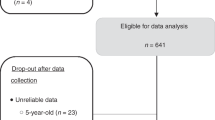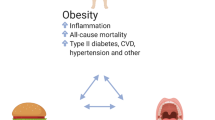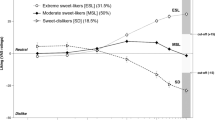Abstract
Background:
The ability to taste 6-n-propylthiouracil (PROP) may be associated with body composition, but previous findings from observational studies are conflicting and cannot be interpreted causally. The aim of this study was to estimate the causal association between PROP taster status and body composition in a population-based cohort study.
Methods:
The study was embedded in a population-based prospective birth cohort study. The TAS2R38 genotype (rs713598) was used as an instrumental variable (IV) to obtain unbiased effect estimates of the relation between PROP taster status and body weight (n=3778). Adiposity measures included body mass index (BMI) and fat mass measured by dual- energy X-ray absorptiometry scan at the child’s age of 6 years. Associations were investigated using both ordinary linear regression (OLS) and two-stage least squares regression (2SLS).
Results:
Non-taster girls had higher BMI standard deviation scores (SDS) and higher body fat as compared with taster girls (results from linear regression BMI SDS: –0.09, P=0.023, body fat mass (%): −0.49, P=0.028). The TAS2R38 genotype predicted PROP phenotype (F=240), indicating a strong IV. The 2SLS effect estimates were imprecise but similar to the observational estimates (−0.08 for BMI SDS and −0.46 for body fat mass %) and were not significantly different from the OLS results (Hausman test: P>0.10). For boys there were no differences observed between tasters and non-tasters.
Conclusions:
Our findings suggest a causal relation between PROP taster status and body weight among 6-year-old girls; Mendelian randomization was consistent with conventional estimates. In contrast, body weight among boys appeared to be independent of the PROP taster status. Further research should focus on possible underlying pathways, such as dietary behavior.
This is a preview of subscription content, access via your institution
Access options
Subscribe to this journal
Receive 12 print issues and online access
$259.00 per year
only $21.58 per issue
Buy this article
- Purchase on Springer Link
- Instant access to full article PDF
Prices may be subject to local taxes which are calculated during checkout
Similar content being viewed by others
Abbreviations
- PROP:
-
6-n-propylthiouracil
- MR:
-
Mendelian randomization
- 2 SLS:
-
two-stage least squares
- OLS:
-
ordinary linear regression
- SEP:
-
socioeconomic position
- SDS:
-
standard deviation score
- DXA:
-
dual- energy X-ray absorptiometry
References
Kim UK, Jorgenson E, Coon H, Leppert M, Risch N, Drayna D . Positional cloning of the human quantitative trait locus underlying taste sensitivity to phenylthiocarbamide. Science 2003; 299: 1221–1225.
Tepper BJ . 6-n-Propylthiouracil: a genetic marker for taste, with implications for food preference and dietary habits. Am J Hum Genet 1998; 63: 1271–1276.
Keller KL, Tepper BJ . Inherited taste sensitivity to 6-n-propylthiouracil in diet and body weight in children. Obes Res 2004; 12: 904–912.
Keller KL, Reid A, MacDougall MC, Cassano H, Song JL, Deng L et al. Sex differences in the effects of inherited bitter thiourea sensitivity on body weight in 4-6-year-old children. Obesity (Silver Spring) 2010; 18: 1194–1200.
Tepper BJ, Ullrich NV . Influence of genetic taste sensitivity to 6-n-propylthiouracil (PROP), dietary restraint and disinhibition on body mass index in middle-aged women. Physiol Behav 2002; 75: 305–312.
Goldstein GL, Daun H, Tepper BJ . Adiposity in middle-aged women is associated with genetic taste blindness to 6-n-propylthiouracil. Obes Res 2005; 13: 1017–1023.
Padiglia A, Zonza A, Atzori E, Chillotti C, Calo C, Tepper BJ et al. Sensitivity to 6-n-propylthiouracil is associated with gustin (carbonic anhydrase VI) gene polymorphism, salivary zinc, and body mass index in humans. Am J Clin Nutr 2010; 92: 539–545.
Lumeng JC, Cardinal TM, Sitto JR, Kannan S . Ability to taste 6-n-propylthiouracil and BMI in low-income preschool-aged children. Obesity (Silver Spring) 2008; 16: 1522–1528.
Drewnowski A, Henderson SA, Cockroft JE . Genetic sensitivity to 6-n-propylthiouracil has no influence on dietary patterns, body mass indexes, or plasma lipid profiles of women. J Am Diet Assoc 2007; 107: 1340–1348.
Timpson NJ, Christensen M, Lawlor DA, Gaunt TR, Day IN, Ebrahim S et al. TAS2R38 (phenylthiocarbamide) haplotypes, coronary heart disease traits, and eating behavior in the British Women's Heart and Health Study. Am J Clin Nutr 2005; 81: 1005–1011.
Drewnowski A, Kristal A, Cohen J . Genetic taste responses to 6-n-propylthiouracil among adults: a screening tool for epidemiological studies. Chem Senses 2001; 26: 483–489.
Baranowski JC, Baranowski T, Beltran A, Watson KB, Jago R, Callie M et al. 6-n-Propylthiouracil sensitivity and obesity status among ethnically diverse children. Public Health Nutr 2010; 13: 1587–1592.
Keller KL, Steinmann L, Nurse RJ, Tepper BJ . Genetic taste sensitivity to 6-n-propylthiouracil influences food preference and reported intake in preschool children. Appetite 2002; 38: 3–12.
Tepper BJ, Nurse RJ . Fat perception is related to PROP taster status. Physiol Behav 1997; 61: 949–954.
Tepper BJ, Koelliker Y, Zhao L, Ullrich NV, Lanzara C, d'Adamo P et al. Variation in the bitter-taste receptor gene TAS2R38, and adiposity in a genetically isolated population in Southern Italy. Obesity (Silver Spring) 2008; 16: 2289–2295.
Lawlor DA, Harbord RM, Sterne JA, Timpson N, Davey Smith G . Mendelian randomization: using genes as instruments for making causal inferences in epidemiology. Stat Med 2008; 27: 1133–1163.
Smith GD, Ebrahim S . Mendelian randomization: prospects, potentials, and limitations. Int J Epidemiol. 2004; 33: 30–42.
Sheehan NA, Didelez V, Burton PR, Tobin MD . Mendelian randomisation and causal inference in observational epidemiology. PLoS Med 2008; 5: e177.
Adler E, Hoon MA, Mueller KL, Chandrashekar J, Ryba NJ, Zuker CS . A novel family of mammalian taste receptors. Cell 2000; 100: 693–702.
Sacerdote C, Guarrera S, Smith GD, Grioni S, Krogh V, Masala G et al. Lactase persistence and bitter taste response: instrumental variables and Mendelian randomization in epidemiologic studies of dietary factors and cancer risk. Am J Epidemiol 2007; 166: 576–581.
Jaddoe VW, Bakker R, van Duijn CM, van der Heijden AJ, Lindemans J, Mackenbach JP et al. The Generation R Study Biobank: a resource for epidemiological studies in children and their parents. Eur J Epidemiol 2007; 22: 917–923.
Jaddoe VW, van Duijn CM, van der Heijden AJ, Mackenbach JP, Moll HA, Steegers EA et al. The Generation R Study: design and cohort update until the age of 4 years. Eur J Epidemiol 2008; 23: 801–811.
Jaddoe VW, van Duijn CM, van der Heijden AJ, Mackenbach JP, Moll HA, Steegers EA et al. The Generation R Study: design and cohort update 2010. Eur J Epidemiol 2010; 25: 823–841.
World Medical Association I. Declaration of Helsinki. Ethical principles for medical research involving human subjects. J Indian Med Assoc 2009; 107: 403–405.
Mennella JA, Pepino MY, Reed DR . Genetic and environmental determinants of bitter perception and sweet preferences. Pediatrics 2005; 115: e216–e222.
Growth Analyzer 3.0, Dutch Growth Research Foundation, Rotterdam, The Netherlands 2007.
International HapMap C Frazer KA, Ballinger DG, Cox DR, Hinds DA, Stuve LL et al. A second generation human haplotype map of over 3.1 million SNPs. Nature 2007; 449: 851–861.
Angrist JD, Krueger AB . Instrumental variables and the search for identification: from supply and demand to natural experiments. J Econ Perspect 2001; 15: 69–85.
Overberg J, Hummel T, Krude H, Wiegand S . Differences in taste sensitivity between obese and non-obese children and adolescents. Arch Dis Child 2012; 97: 1048–1052.
Berthoud HR, Zheng H . Modulation of taste responsiveness and food preference by obesity and weight loss. Physiol Behav 2012; 107: 527–532.
Glymour MM, Tchetgen EJ, Robins JM . Credible Mendelian randomization studies: approaches for evaluating the instrumental variable assumptions. Am J Epidemiol 2012; 175: 332–339.
Dotson CD, Shaw HL, Mitchell BD, Munger SD, Steinle NI . Variation in the gene TAS2R38 is associated with the eating behavior disinhibition in Old Order Amish women. Appetite 2010; 54: 93–99.
Duffy VB . Associations between oral sensation, dietary behaviors and risk of cardiovascular disease (CVD). Appetite 2004; 43: 5–9.
Fox AL . The relationship between chemical constitution and taste. Proc Natl Acad Sci USA 1932; 18: 115–120.
Bell KI, Tepper BJ . Short-term vegetable intake by young children classified by 6-n-propylthoiuracil bitter-taste phenotype. Am J Clin Nutr 2006; 84: 245–251.
Feeney E, O'Brien S, Scannell A, Markey A, Gibney ER . Genetic variation in taste perception: does it have a role in healthy eating? Proc Nutr Soc 2011; 70: 135–143.
Bartoshuk LM, Duffy VB, Miller IJ . PTC/PROP tasting: anatomy, psychophysics, and sex effects. Physiol Behav. 1994; 56: 1165–1171.
Calo C, Padiglia A, Zonza A, Corrias L, Contu P, Tepper BJ et al. Polymorphisms in TAS2R38 and the taste bud trophic factor, gustin gene co-operate in modulating PROP taste phenotype. Physiol Behav 2011; 104: 1065–1071.
Bufe B, Breslin PA, Kuhn C, Reed DR, Tharp CD, Slack JP et al. The molecular basis of individual differences in phenylthiocarbamide and propylthiouracil bitterness perception. Curr Biol 2005; 15: 322–327.
Bartoshuk LM, Catalanotto F, Hoffman H, Logan H, Snyder DJ . Taste damage (otitis media, tonsillectomy and head and neck cancer), oral sensations and BMI. Physiol Behav 2012; 107: 516–526.
Kiefte-de Jong JC, de Vries JH, Bleeker SE, Jaddoe VW, Hofman A, Raat H et al. Socio-demographic and lifestyle determinants of 'Western-like' and 'Health conscious' dietary patterns in toddlers. Br J Nutr 2013; 109: 137–147.
North K, Emmett P . Multivariate analysis of diet among three-year-old children and associations with socio-demographic characteristics. The Avon Longitudinal Study of Pregnancy and Childhood (ALSPAC) Study Team. Eur J Clin Nutr 2000; 54: 73–80.
Brown SD, Harris G, Bell L, Lines LM . Disliked food acting as a contaminant in a sample of young children. Appetite 2012; 58: 991–996.
Reed DR, Bartoshuk LM, Duffy V, Marino S, Price RA . Propylthiouracil tasting: determination of underlying threshold distributions using maximum likelihood. Chem Senses 1995; 20: 529–533.
Acknowledgements
The Generation R Study is conducted by the Erasmus Medical Centre in close collaboration with the Erasmus University Rotterdam, School of Law and Faculty of Social Sciences, the Municipal Health Service Rotterdam area, Rotterdam, the Rotterdam Homecare Foundation, Rotterdam, and the Stichting Trombosedienst and Artsenlaboratorium Rijnmond (STAR), Rotterdam. We acknowledge the contribution of general practitioners, hospitals, midwives, and pharmacies in Rotterdam. The first phase of the Generation R Study is made possible by financial support from: Erasmus Medical Centre, Rotterdam, Erasmus University Rotterdam, and the Netherlands Organization for Health Research and Development (ZonMw).
Author information
Authors and Affiliations
Corresponding author
Ethics declarations
Competing interests
The authors declare no conflict of interest.
Additional information
Supplementary Information accompanies this paper on International Journal of Obesity website
Supplementary information
Rights and permissions
About this article
Cite this article
Bouthoorn, S., van Lenthe, F., Kiefte-de Jong, J. et al. Genetic taste blindness to bitter and body composition in childhood: a Mendelian randomization design. Int J Obes 38, 1005–1010 (2014). https://doi.org/10.1038/ijo.2013.141
Received:
Revised:
Accepted:
Published:
Issue Date:
DOI: https://doi.org/10.1038/ijo.2013.141
Keywords
This article is cited by
-
Using Animal Models to Determine the Role of Gustatory Neural Input in the Control of Ingestive Behavior and the Maintenance of Body Weight
Chemosensory Perception (2015)
-
The Generation R Study: Biobank update 2015
European Journal of Epidemiology (2014)



